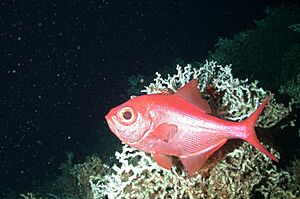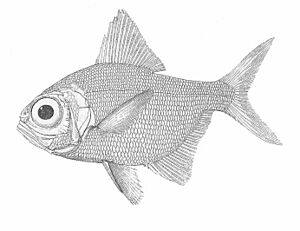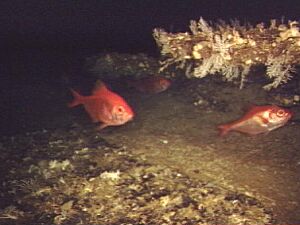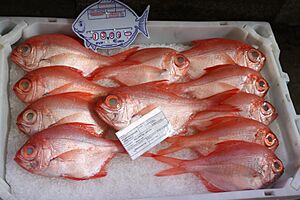Alfonsino facts for kids
Quick facts for kids Alfonsino |
|
|---|---|
 |
|
| Conservation status | |
| Scientific classification | |
| Genus: |
Beryx
|
| Species: |
decadactylus
|
The alfonsino (Beryx decadactylus) is a cool deep-sea fish. It's also known as the longfinned beryx or red bream. You can find it in warm and mild ocean waters all over the world, but it's not very common. It often hangs out near deep-sea corals and forms groups over underwater mountains called seamounts. Alfonsinos are bottom-dwellers, meaning they look for food like smaller fish, squid, and crabs along the ocean floor. These fish live a very long time, sometimes up to 69 years or even more! They can grow to about 1 m (3.3 ft) long and weigh up to 2.5 kg (5.5 lb). People catch them for food, but because they grow slowly and don't have many babies, they can be easily overfished. Still, they are listed as "Least Concern" by conservation groups because they live in so many different places.
About Its Name
The first scientific description of the alfonsino was written in 1829 by Georges Cuvier. He was a famous scientist who studied fish. He first named it Beryx dodecadactylus. Later, in 1990, another scientist named G. E. Maul changed its name to B. decadactylus. The meaning of its first name, Beryx, isn't fully clear. It might come from an old Greek word for a fish.
What It Looks Like
The alfonsino has big eyes and a body that is deep but also flattened from side to side. It's a beautiful rose-red color on its back and orange on its belly. The rest of its body is silvery-pink, and its chest is yellowish-white. Its fins and the inside of its mouth are bright red. The fin on its underside (called the anal fin) is much bigger than in many other fish. Its tail fin is deeply forked, like a "V" shape.
Its bright red color helps it hide in the deep ocean. Red light doesn't reach deep waters, so the fish looks dark or black to other creatures, making it harder to spot. While most alfonsinos are about 35.0 cm (13.8 in) long, they can grow up to 100.0 cm (39.4 in)! The heaviest alfonsino ever recorded weighed about 2.5 kg (5.5 lb). Young alfonsinos have sharp spines on their heads, but these disappear as they get older.
Where It Lives
The alfonsino lives all over the world in warm and mild ocean waters. You can find it from as far north as Greenland and Iceland down to Brazil in the western Atlantic Ocean. In the eastern Atlantic, it's found near South Africa. In the Indo-Pacific region, it lives from South Africa all the way to Japan, Australia, and New Zealand. It has also been seen off the coasts of Argentina and Hawaii.
This fish lives deep underwater, usually between 110–1,000 m (360–3,280 ft) below the surface. It likes to gather in groups near deep-sea coral habitats on the edges of continents, called the continental shelf and continental slope. During the day, it stays in deeper water. At night, it swims up to shallower waters to feed. It's most often found about 200–400 m (660–1,310 ft) deep, where the water temperature is around 24 °C (75 °F). The exact depth it lives at can change depending on the region.
How It Lives
Alfonsinos live near the ocean floor and gather over deep-ocean seamounts, often close to deep-sea corals. At night, they swim up closer to the surface. Their main foods are crustaceans (like crabs and shrimp), cephalopods (like squid), and small fish. Small fish are the most common food in their diet.
Alfonsinos usually lay their eggs in the summer, from June to September. However, males can be ready to reproduce all year. They are "batch spawners," meaning they release eggs many times over a long period, not just once. The eggs and young larvae float near the ocean's surface. Eggs hatch in about 27 hours. The tiny larvae are only 1.5–3.0 mm (0.059–0.118 in) long at first.
As they grow, young alfonsinos develop their fins and scales. They have long pelvic fins and spines on their back fin. Young fish live deeper, but they still float in the open water for a few months. Eventually, they move to the ocean floor, where they will live as adults. They become old enough to reproduce after about 4 years, when they are around 30 cm (12 in) long. Females are usually a bit bigger than males. Alfonsinos grow slowly, which is common for fish in their family. We don't know their exact maximum age, but some have been caught at 69 years old. Scientists think they might live as long as 85 years!
Alfonsinos and People
Alfonsinos are important fish for commercial fishing. Fishermen use methods like deep-water trawling (dragging large nets) and longline fishing (using long lines with many hooks) to catch them. They are caught in places like Spain, Mauritania, the southeastern United States, Japan, and the Canary Islands.
Sometimes, alfonsinos are also caught by accident when fishermen are trying to catch other types of fish. This is called "bycatch." Because of this, some worry that there might be fewer alfonsinos than we think. Even though they are found in many places, alfonsinos are not common in some areas. This is likely because of fishing and bycatch.
Despite these concerns, the alfonsino is listed as "Least Concern" by the International Union for Conservation of Nature (IUCN). This is because they live in such a wide area, which helps protect them from becoming extinct. Also, in some parts of the world, they are not a main target for fishing. However, deep-water trawling can damage their habitat, especially the deep-sea corals they live near.





